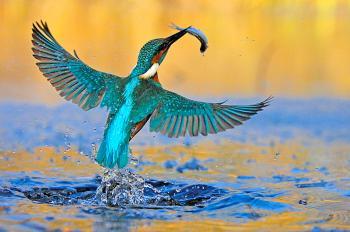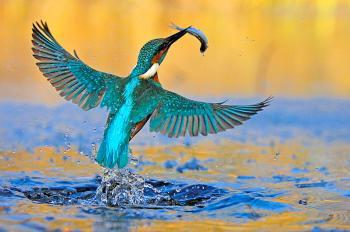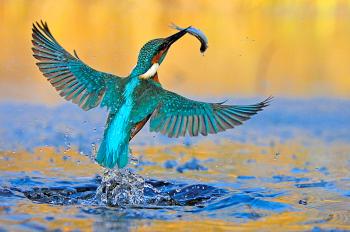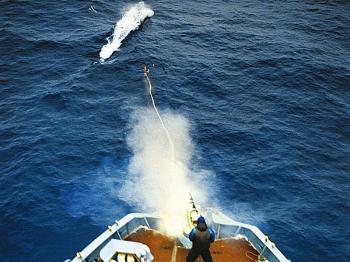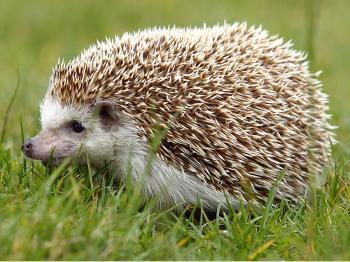From the beak to the tip of the tail, the bird measures 16 cm long. Its short legs and tail feathers make it appear a bit clumsy, but its flight is so swift that predators present no danger. Present estimates of breeding pairs range from 5,000 to 8,000 in Germany alone. In the vicinity of Hamburg, the estimated kingfisher population consists of 35–40 breeding pairs.
The Kingfisher’s Diet
The kingfisher eats insects and occasionally dines on small frogs, but its favorite food is small fish, thus earning it the name “King of Fishers.” The bird leans slightly forward while sitting on a branch approximately a meter above the water surface, and keeps an eye out for its next meal—perhaps a Rotauge or a Stichling.
Once the kingfisher selects its prey, it dives vertically into the water, sometimes as deep as 60 cm, unless the water is shallower or the bird’s sight is off. Two seconds later it emerges, clutching a prize in its beak.
When the water is clear, the kingfisher has a 100 percent success rate. Upon securing a fish, the bird kills it by knocking it on a branch, even though the prey might measure 10 cm or more. It won’t miss eating a single morsel and consumes up to 30 grams of food daily, virtually the same amount as its weight, which is 35 to 40 grams. The kingfisher’s life is strenuous because it has to feed many young each season—many mouths require many fish.
A Loner With Loyalty to Family
The kingfisher is a loner during the winter months and does not tolerate others of its kind in its territory. But this changes during breeding season when the male calls the female. This leads to negotiations with possible mates—lengthy flights of pursuit, flat across the water and high above the trees, coupled with many freshly caught fish as offerings to the female.
The pair has a month-long encounter. Most of these pairings are monogamous, but occasionally not. However, the male will take care of both his families then! This is quite a feat, considering the birds breed three times a year, and sometimes four.
Beaks at the End of a Tunnel
Before egg-laying commences, the female must ready the nursery. This involves the pair taking turns digging a 40–80 cm long tunnel with their beaks into a steep clay or sand bank. The pair favors collapsed shore walls, but in a pinch they will dig into the root system of a fallen tree.
At the end of the tunnel, the parents create a football-size hollow to serve as the nest. They prefer to use a cleaned-out existing nest from prior years, even if it was not originally their own.
Eggs are laid on the bare ground. The parents take turns egg-sitting for three weeks. Once the eggs hatch, both parents feed their chicks for four weeks. Several days after the young have begun flight, around May or June, they will have already been shoved out of the parents’ territory, and the breeding process starts over.
During the third breeding of young, the male continues to feed the nestlings until they take flight, while the female is already at work digging a new breeding tunnel. That is called “Schachtelbrut.”
Each clutch has six or seven eggs, which means that a huge amount of fish is needed to feed all the hungry mouths. That requires clean and calm waters, to ensure precise hunting success. Rivers and lakes that are polluted with various effluents do not provide food for the kingfisher.
Not an Easy Life
On average, up to 70 percent of all adult kingfisher die, as do 80 percent of the new hatchlings, according to NABU (German Nature Conservation Association). Kingfishers are non-migratory in Germany and only leave their territory if the waters freeze over. If the frosts last too long, the birds will perish.
Nevertheless, the birds do not benefit from climate change. Floodwaters run faster and are muddy. Besides that, floodwater can inundate the breeding tunnels and drown the young.
In addition, finding a nesting site is becoming ever more difficult for the kingfisher. It could very well be that they do not approach their nesting sites because humans seeking recreation have encroached on their spots by permanently reinforcing shore areas with rocks. The young sometimes wait in vain for the parents to return and feed them.
Bird of the Year 2009
This is the second time since1973 that NABU and the Landesbund für Vogelschutz (LBV) (The Society for the Protection of Birds) has selected the kingfisher as Bird of the Year—this time for 2009. The bird represents the living rivers and meadows that make up its territory.
NABU has begun a huge, federally sanctioned and funded project to let the Havel River return to its natural course and do away with the many dikes and gradations. The project will permit the river to once again meander in a natural pattern through meadows, ponds, and flood plains. The area is hopefully set to become a paradise for animals and humans and, of course, for the Flying Jewels.

